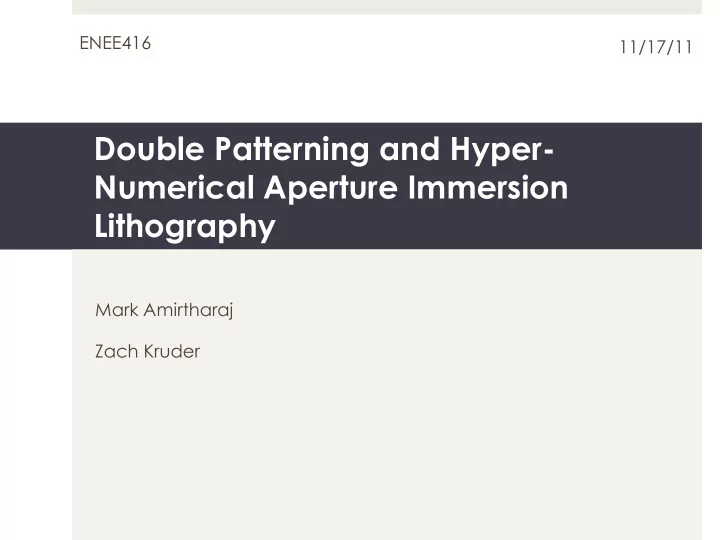

ENEE416 11/17/11 Double Patterning and Hyper- Numerical Aperture Immersion Lithography Mark Amirtharaj Zach Kruder
Double Patterning Lithography Introduction Background No new technology is introduced Viewed as a short term solution to keep pace with Moore’s Law When used with immersion techniques it can produce feature sizes of 32nm and beyond [1] Techniques Three main techniques Lithography-Etch, Lithography-Etch (LELE) Lithography-Freeze, Lithography Etch (LFLE) Self-Alignment Double Patterning (SADP)
Double Patterning Lithography Litho-Etch, Litho-Etch (LELE) LELE Process Steps [2]
Litho-Etch Litho-Etch (LELE) Advantages/Disadvantages Advantages No new technology Allows for greater resolution Uses existing technology Straightforward process Disadvantages Requires 5 process steps Expensive – litho-etch process twice Low throughput Small tolerance for pattern overlay
Double Patterning Lithography Litho-Freeze Litho-Etch (LFLE) LFLE Process Steps [2]
Litho-Freeze Litho-Etch (LFLE) Advantages/Disadvantages Advantages Four process steps (five for LELE) Reduced cost Increased throughput Disadvantages Faces same issues with small overlay tolerance LFLE Example [3]
Double Patterning Lithography Self-Aligned Double Patterning (SADP) SADP Process Steps [2]
Self-Aligned Double Patterning (SADP) Advantages/Disadvantages Advantages Disadvantages Eliminates trouble with Increased process steps – pattern overlay tolerance increased cost Optimized for processes with uniform patterns SADP Example[3]
Double Patterning Lithography Applications Memory Devices Self-Aligned Double Patterning (SADP) Used because these devices typically have uniform patterns Used by Hynix, Micron, Renesas, and Samsung Logic Devices Litho-Etch, Litho-Etch (LELE) and Litho-Freeze, Litho-Etch (LFLE) Used because these devices typically have non-uniform patterns Used by Intel, Sony, TI, Toshiba, and TSMC
Hyper-Numerical Aperture Immersion Lithography Background Similar to conventional projection lithography Currently viable method to keep up with Moore’s Law Enhances resolution
Process Details Light source: 193 ArF excimer laser Similarity to conventional projection lithography seen in presence of mask and lens. However, air-gap present between the wafer and lens is replaced by liquid medium. Most common medium is highly purified deionized water. Liquid medium will have higher refractive index than 1. Liquid in direct contact with lens and photoresist on wafer. Optimal processing done with water-resistant photoresist.
Immersion Lithography Set-up Zeiss [5] IBM [4]
Why a liquid medium? Acheivable resolution for devices is directly related to the Numerical Aperture of the lithography equipment. NA = sin(max. refraction angle) * (refractive index of liquid) With a liquid medium refractive index of greater than 1, there is a larger depth of focus and minimal reflection of the projected laser light, resulting in higher resolution of patterns exposed onto the photoresist on the wafer. Increases in resolution can range between 30-40% depending on the liquid used. By using immersion lithography, we can achieve smaller feature sizes withouth having to overhaul all equipment to costly x-ray lithography systems, for example.
Disadvantages Bubbles in the fluid as well as thermal and pressure variations in the fluid can lead to processing disortions. Possibility of 193nm ArF laser ionized the liquid medium and promoting reaction with photoresist, thus altering the accuracy of desired features. When wafer is removed from apparatus, residual moisture might remain due to direct contact with liquid. Moisture will impede optimal device performance and processing. More expensive than conventional dry lithography.
Applications Industry leaders using immersion lithography: Intel Texas Instruments Nikon IBM ASML Toshiba Purpose: to achieve feature sizes around 25nm without having to shift to inordinately expensive equipment such as x-ray systems. Immersion lithography combined with double patterning results in even finer acheivable feature sizes. Allows companies to keep up with Moore’s Law. Able to create nodes of 32nm and 22nm.
References [1] P. Zimmerman, “Double patterning lithography: double the trouble or double the fun ,” SPIE Newsroom, [Online]. Available: http://spie.org/documents/Newsroom/Imported/1691/1691_5999_0_2009-06-24.pdf [2] “All Double - Patterning Variations Lead to Rome,” IEEE Spectrum, [Online]. Available: http://spectrum.ieee.org/images/nov08/images/doub03.pdf [3] “ Litho-Freeze-Litho-Etch (LFLE) enabling coat/develop track process, ” Applied Materials, [Online]. Available: http://www.sematech.org/meetings/archives/litho/8715/pres/O-DPMP- 03_Pieczulewski_SOKUDO.pdf [4] “Immersion Lithography,” IBM, [Online]. Available: http://www.almaden.ibm.com/st/chemistry/lithography/immersion/ [5] “Optics for 193nm Immersion Lithography,” Carl Zeiss, [Online]. Available: http://www.zeiss.de/c12567b0003c017a/Contents- Frame/0358803766924803c12567b0003d5d3f [6] B.W. Smith, Y. Fan, M. Slocum, L. Zavyalova , “25nm Immersion Lithography at a 193nm Wavelength,” Rochester Institute of Technology, Proceedings of SPIE, SPIE Microlithography, Optical Microlithography XVIII, Immersion Lithography, 5754, San Jose, California, United States, pp. 141-147 (2005).
Recommend
More recommend